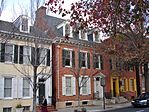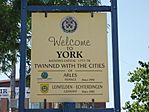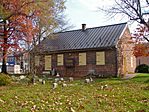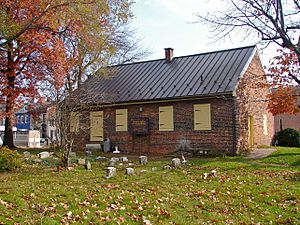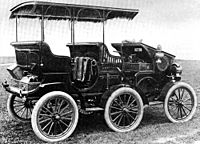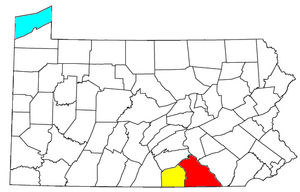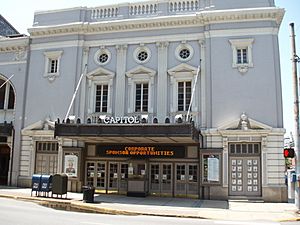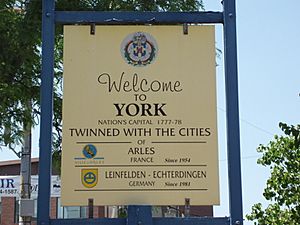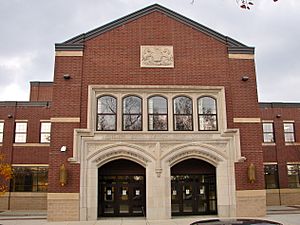York, Pennsylvania facts for kids
Quick facts for kids
York, Pennsylvania
|
|
|---|---|
|
Clockwise from top left: Appell Center for the Performing Arts, William Goodridge house, York Friends Meeting House, and welcome sign
|
|
| Nickname(s):
The White Rose City
|
|

Location in York County and the U.S. state of Pennsylvania.
|
|
| Country | United States |
| State | Pennsylvania |
| County | York |
| Laid out | 1741 |
| - Borough | September 24, 1787 |
| - City | January 11, 1887 |
| Area | |
| • City | 5.34 sq mi (13.84 km2) |
| • Land | 5.29 sq mi (13.71 km2) |
| • Water | 0.05 sq mi (0.13 km2) |
| Population
(2020)
|
|
| • City | 44,800 |
| • Density | 8,389.5/sq mi (3,237.0/km2) |
| • Urban | 232,045 |
| Time zone | UTC−5 (EST) |
| • Summer (DST) | UTC−4 (EDT) |
| ZIP code |
17401, 17403, 17404, 17405
|
| Area code(s) | 717 and 223 |
| FIPS code | 42-87048 |
York (Pennsylvania German: Yarrick), known as the White Rose City (after the symbol of the House of York), is the county seat of York County, Pennsylvania, United States, located in the south-central region of the state. The population within York's city limits was 43,718 at the 2010 census, a 7.0% increase from the 2000 census count of 40,862. When combined with the adjacent boroughs of West York and North York and surrounding Spring Garden, West Manchester, and Springettsbury townships, the population of Greater York was 108,386. York is the 11th largest city in Pennsylvania.
Contents
History
Architecture
The city has been called an "architectural museum," because the downtown features numerous well-preserved historic structures, such as the 1741 Golden Plough Tavern, the 1751 General Horatio Gates House, the 1766 York Meetinghouse, the 1863 Billmeyer House, the 1888 York Central Market, and the 1907 Moorish Revival Temple Beth Israel. Other notable buildings are the Laurel-Rex Fire Company House, Forry House, Farmers Market, Barnett Bobb House, Cookes House, United Cigar Manufacturing Company building, Stevens School, York Dispatch Newspaper Offices, and York Armory.
The city is home to four national historic districts: Fairmount Historic District, Northwest York Historic District, Springdale Historic District, and York Historic District.
18th century
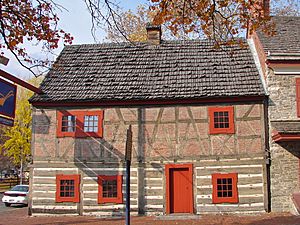
York, also known as Yorktown in the mid 18th to early 19th centuries, was founded in 1741 by settlers from the Philadelphia region and named for the English city of the same name. By 1777, most of the area residents were of either German or Scots-Irish descent. York was incorporated as a borough on September 24, 1787, and as a city on January 11, 1887. During the American Revolutionary War (1775–1783), York served as the temporary capital of the Continental Congress. The Articles of Confederation were drafted and adopted in York, though they were not ratified until March 1781.
York styles itself the first Capital of the United States, although historians generally consider it to be the fourth capital, after Philadelphia, Baltimore and Lancaster. The claim arises from the assertion that the Articles of Confederation was the first legal document to refer to the colonies as "the United States of America". The argument depends on whether the Declaration of Independence, which also uses the term, would be considered a true legal document of the United States, being drafted under and in opposition to British rule. This does not, however, prevent modern businesses and organizations in the York area, such as the First Capital Dispensing Co., First Capital Engineering and First Capital Federal Credit Union from using the name.
The Conway Cabal, a political intrigue against General George Washington, had its origins in the Golden Plough Tavern in York.
19th century
According to U.S. census reports from 1800 through 1840, York ranked within the nation's top 100 most populous urban areas.
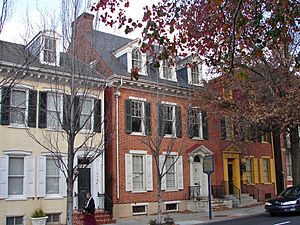
During the American Civil War (1861–1865), York became the largest Northern town to be occupied by the Confederate army when the division of Major General Jubal Anderson Early spent June 28–30, 1863, in and around the town while the brigade of John B. Gordon marched to the Susquehanna River at Wrightsville and back. Early laid York under tribute and collected food, supplies, clothing, shoes, and $28,000 in cash from citizens and merchants before departing westward obeying the revised orders of Robert E. Lee. The sprawling York U.S. Army Hospital on Penn Commons served thousands of Union soldiers wounded at the battles of Antietam and Gettysburg.
In the Postbellum era (1865–1877), York remained a regional center for local agriculture, but increasingly became an important industrial center, with such industries as steam engines, railroad manufacturing, and papermaking coming to the forefront. York also features some unique architecture ranging from colonial era buildings to large gothic churches.
20th century
The York Motor Car Co. built Pullman automobiles on North George St. from 1905 thorough 1917. An early and unique six-wheeled prototype was involved in one of the city's first known automobile accidents. Another model was driven to San Francisco and back over about one month to prove its reliability several years before the creation of the Lincoln Highway which ran through town, connecting New York and San Francisco.
The York area had also been home for more than 100 years to the Pfaltzgraff company, which built its first pottery factory in the area in 1895 and continued manufacturing in York until 2005. Though now produced by The Hershey Company, the York Peppermint Pattie was created in York in 1940.
Throughout the middle 20th Century, the black residents of the city were subject to hostile racial prejudice and social injustices. Between 1955 and 1970, the people of York experienced racial discrimination leading to riots, most notably the 1969 York Race Riot, which resulted in the death of Lily Allen and Henry C. Schaad. These murders were largely left ignored until 31 years later, when allegations of murder and racial prejudice were raised against the mayor at the time, Charlie Robertson. Additionally, throughout the entire century, the city commonly held unopposed Ku Klux Klan rallies and public meetings, despite continuous racial tensions. Though the murders of Allen and Schaad were solved and the perpetrators were apprehended, the actions, which originate back to the beginnings of the hate group, continue to present day.
21st century
In 2002, the city faced a budget shortfall of $1,000,000. Mayor John S. Brenner's plan to raise the money by asking York County's 302,000 adult residents to donate $3.32 to the city received national attention. The plan, referred to by some as the "Big Mac" Plan, did not raise all the monies sought.
After many years of attempting to secure funding for a stadium and a baseball team to play in it, the first decade of the century saw York realize both goals. In 2007, Santander Stadium, home of the York Revolution, opened in the Arch Street neighborhood. The stadium, along with other large projects such as the York County Judicial Center and the Codo 241 luxury apartment lofts, symbolizes York's extensive redevelopment efforts
York was featured during the 2008 U.S. Presidential Election, when National Public Radio's Michele Norris and Steve Inskeep chose to showcase the city in "The York Project: Race & the '08 Vote." The program was aired as a 7-part series and featured different York citizens discussing race relations, racial perceptions, and the emotions inspired by the 2008 election. Norris stated that York was chosen due to its central location in a battleground state, its rich history (including its strained race relations), and demographics. On June 19, 2009, Norris announced on the air that she was taking time off to write a book inspired by her conversations "with a diverse group of voters" in York, and The Grace of Silence: A Memoir was published in September 2010.
In 2009, Kim Bracey won the Democratic primary and became the favored candidate for mayor. She won the general election in November against Republican opponent Wendell Banks and took office on the first Monday in 2010 as the city's first African-American and second woman mayor. Bracey won reelection in November 2013 against Libertarian challenger Dave Moser.
Geography and climate
York is located at 39°57′46″N 76°43′41″W / 39.96278°N 76.72806°W (39.962692, −76.728043).
 |
Carlisle | Harrisburg | Lebanon, Reading |  |
| Gettysburg, Chambersburg | Lancaster, Philadelphia | |||
| Hanover, Frederick, Westminster | Baltimore, Washington, D.C. | Philadelphia |
According to the United States Census Bureau, the city has a total area of 5.3 square miles (14 km2), of which, 5.2 square miles (13 km2) of it is land and 0.1 square miles (0.26 km2) of it (1.14%) is water.
Like most of Pennsylvania, York has a humid continental climate, it is characterized by warm to hot, humid summers and moderately cold winters. The mean annual precipitation total of 41.1 in (1,040 mm) is fairly evenly spread throughout the year, and falls on an average of 126.6 days per annum. Record temperatures from the York COOP range from 107 °F (42 °C), set on July 2, 1901, down to −21 °F (−29 °C), recorded on January 28, 1925 and January 21, 1994; at York Airport, with a considerably shorter period of record, the range is 100 °F (38 °C), set on July 22, 2011, down to −12 °F (−24 °C) as recently as March 7, 2015.
| Climate data for York Airport, Pennsylvania (1981–2010 normals, extremes 1997–present) | |||||||||||||
|---|---|---|---|---|---|---|---|---|---|---|---|---|---|
| Month | Jan | Feb | Mar | Apr | May | Jun | Jul | Aug | Sep | Oct | Nov | Dec | Year |
| Record high °F (°C) | 72 (22) |
75 (24) |
86 (30) |
91 (33) |
93 (34) |
96 (36) |
100 (38) |
99 (37) |
95 (35) |
90 (32) |
84 (29) |
78 (26) |
100 (38) |
| Average high °F (°C) | 38.6 (3.7) |
41.7 (5.4) |
51.5 (10.8) |
63.0 (17.2) |
72.5 (22.5) |
81.1 (27.3) |
84.8 (29.3) |
83.5 (28.6) |
75.9 (24.4) |
65.7 (18.7) |
54.4 (12.4) |
42.3 (5.7) |
63.0 (17.2) |
| Average low °F (°C) | 20.6 (−6.3) |
22.3 (−5.4) |
29.3 (−1.5) |
39.0 (3.9) |
48.9 (9.4) |
58.7 (14.8) |
62.8 (17.1) |
60.7 (15.9) |
52.8 (11.6) |
41.4 (5.2) |
33.9 (1.1) |
24.6 (−4.1) |
41.3 (5.2) |
| Record low °F (°C) | −12 (−24) |
−12 (−24) |
−12 (−24) |
17 (−8) |
28 (−2) |
39 (4) |
44 (7) |
42 (6) |
32 (0) |
22 (−6) |
12 (−11) |
−10 (−23) |
−12 (−24) |
| Average precipitation inches (mm) | 2.93 (74) |
2.73 (69) |
3.51 (89) |
3.44 (87) |
3.98 (101) |
3.34 (85) |
3.69 (94) |
3.57 (91) |
4.26 (108) |
3.26 (83) |
3.46 (88) |
2.97 (75) |
41.14 (1,045) |
| Average snowfall inches (cm) | 8.9 (23) |
8.1 (21) |
3.5 (8.9) |
0.5 (1.3) |
0 (0) |
0 (0) |
0 (0) |
0 (0) |
0 (0) |
0 (0) |
0.8 (2.0) |
3.2 (8.1) |
25.0 (64) |
| Average precipitation days (≥ 0.01 in) | 10.0 | 9.8 | 11.1 | 12.1 | 12.8 | 11.7 | 10.9 | 10.0 | 9.5 | 8.4 | 10.3 | 10.0 | 126.6 |
| Average snowy days (≥ 0.1 in) | 3.8 | 2.7 | 1.5 | 0.3 | 0 | 0 | 0 | 0 | 0 | 0 | 0.5 | 1.7 | 10.5 |
| Source: NOAA (snow, precipitation days, and snow days from York 3 SSW Pump Station COOP) | |||||||||||||
Demographics
| Historical population | |||
|---|---|---|---|
| Census | Pop. | %± | |
| 1790 | 2,096 | — | |
| 1800 | 2,503 | 19.4% | |
| 1810 | 2,847 | 13.7% | |
| 1820 | 3,107 | 9.1% | |
| 1830 | 4,216 | 35.7% | |
| 1840 | 4,779 | 13.4% | |
| 1850 | 6,803 | 42.4% | |
| 1860 | 8,603 | 26.5% | |
| 1870 | 11,003 | 27.9% | |
| 1880 | 13,940 | 26.7% | |
| 1890 | 20,793 | 49.2% | |
| 1900 | 33,708 | 62.1% | |
| 1910 | 44,750 | 32.8% | |
| 1920 | 47,512 | 6.2% | |
| 1930 | 55,254 | 16.3% | |
| 1940 | 56,712 | 2.6% | |
| 1950 | 59,953 | 5.7% | |
| 1960 | 54,504 | −9.1% | |
| 1970 | 50,008 | −8.2% | |
| 1980 | 44,619 | −10.8% | |
| 1990 | 42,192 | −5.4% | |
| 2000 | 40,862 | −3.2% | |
| 2010 | 43,718 | 7.0% | |
| 2020 | 44,800 | 2.5% | |
| U.S. Decennial Census | |||
York is the largest principal city of the York–Hanover–Gettysburg CSA, a Combined Statistical Area that includes the York–Hanover metropolitan area (York County) and the Gettysburg micropolitan area (Adams County), which had a combined population of 473,043 at the 2000 census.
2010
As of the 2010 census, the city was 51.2% White, 28.0% Black or African American, 0.6% Native American, 1.2% Asian, and 6.3% were two or more races. 28.5% of the population were of Hispanic or Latino ancestry.
2000
As of the census of 2000, there were 40,862 people, 16,137 households, and 9,246 families residing in the city. The population density was 7,852.2 inhabitants per square mile (3,031.8/km2). There were 18,534 housing units at an average density of 3,561.6/sq mi (1,375.1/km2). The racial makeup of the city was 59.75% White, 25.13% African American, 0.42% Native American, 1.40% Asian, 0.07% Pacific Islander, 9.40% from other races, and 3.83% from two or more races. Hispanic or Latino of any race were 17.19% of the population.
There were 16,137 households, out of which 30.9% had children under the age of 18 living with them, 31.0% were married couples living together, 20.6% had a female householder with no husband present, and 42.7% were non-families. 33.1% of all households were made up of individuals, and 10.7% had someone living alone who was 65 years of age or older. The average household size was 2.48 and the average family size was 3.17.
In the city, the population was spread out, with 28.4% under the age of 18, 11.4% from 18 to 24, 30.1% from 25 to 44, 19.1% from 45 to 64, and 10.9% who were 65 years of age or older. The median age was 31 years. For every 100 females, there were 93.0 males. For every 100 females age 18 and over, there were 88.0 males.
The median income for a household in the city was $26,475, and the median income for a family was $30,762. Males had a median income of $26,792 versus $20,612 for females. The per capita income for the city was $13,439. About 20.0% of families and 23.8% of the population were below the poverty line, including 31.8% of those under age 18 and 15.8% of those age 65 or over.
Culture
Fairgrounds and vendors
Much of York's culture represents the city's evolving role as an agricultural and industrial center. The historic York Fair, which claims to be the country's oldest, traces its roots to 1765. It runs every year in September for 10 days, encompassing an entire week and two weekends. In addition to typical fair attractions, such as rides, games and contests, it also wins regional recognition for hosting many (usually country) musical artists, such as Alabama, Gretchen Wilson, Carrie Underwood, Toby Keith, and Lynyrd Skynyrd.
The fairgrounds, branded the York Expo Center, also hosts the annual National Street Rod Association Street Rod Nationals East, the largest annual street rod event in the Eastern US. The event brings thousands of street rods into the city for a few days in June. On Friday afternoon the city holds a parade through the center of the city for participating vehicles.
York City Recreation and Parks helps sponsor the Olde York Street Fair each year on Mothers Day, the second Sunday of May – a tradition since the early 1980s. In recent years more than 150 art, craft and food vendors have lined Market and George streets. Average attendance was 60,000 people as of 2004, according to city officials.
Theatre
York is home to the York Little Theatre and to the Strand-Capitol Performing Arts Center, which brings many nationally acclaimed acts to the York area. Performers here have included Kenny G, Bill Cosby, B.B. King, Béla Fleck, and George Carlin. The historic Capitol Theatre also features many independent and foreign films, making it the only venue in York (and sometimes the entire Susquehanna Valley) to feature some rare, yet critically acclaimed films. The Strand Studio has also branched out from the recently Renovated Strand-Capitol Performing Arts Center. The Studio offers live music, usually jazz & acoustic, for the community.
Heritage
The York County History Center (YCHC) is a not-for-profit educational institution that preserves and uses its collections, historic sites and museums to inspire people to explore the history and culture of York County, Pennsylvania. YCHC maintains eight historical sites that preserve and present 300 years of York County's rich and diverse history. The YCHC was founded in 1999 after a merger of the Historical Society of York County and the Agricultural and Industrial Museum of York County (AIM). Currently, the YCHC historical sites include the Worker's House (c. 1875), Golden Plough Tavern (c.1741), the Barnett Bobb Log House (1812), the Bonham House (c.1885) and old Eastern Market House (c.1886). In 1992, AIM acquired an industrial complex consisting of six buildings (c.1874 to 1955); three of the buildings were renovated and now house the industrial portion of the collection. The YCHC hosts a variety of events throughout the year, and holds the rights to the Murals of York, PA, a group of murals that depict York's rich history. The History Center purchased a former Met-Ed steam plant in York in late 2015, and has plans to turn it into a new history center. In 2016, what was the York County Heritage Trust rebranded as the York County History Center.
Music
The York Factory Whistle holds the world record for the loudest music without amplification from a non-musical instrument. Every Christmas Eve the whistle uses a compressor to create air pressure, then releases it through a series of tubes using a device much like a slide whistle. (Prior to 2010, the pressure was created using steam produced by a boiler.) The music had a loudness of 140 dB and can be heard 10 to 12 miles away with proper weather conditions. Various Christmas music is played for a short time around midnight. It is thought that this annual tradition was started around 1925. After the hosting New York Wire Cloth Company plant closed in 2013, Metso moved the whistle to their factory in York and the annual concert tradition has continued. Metso announced in August 2015 that it would close its York plant by the end of March 2016. Organizers hope to be able to hold the 2016 whistle concert at the same location.
The alternative rock band Live is from York.
York is home to many veteran as well as up-and-coming talented artists and musicians from all genres including funk, blues, jazz, rock, experimental, country, and bluegrass. The rock band Hexbelt is known for its brand of "Susquehanna Hexbelt Swing" music. York hosts a variety of open mics and underground venues such as the Sign of the Wagon and The Depot.
Shopping
The area's main shopping centers are York Galleria and West Manchester Town Center.
Sister cities
York is officially twinned with:
 – Arles, Bouches-du-Rhône, Provence-Alpes-Côte d'Azur, France – since 1954
– Arles, Bouches-du-Rhône, Provence-Alpes-Côte d'Azur, France – since 1954 – Leinfelden-Echterdingen, Baden-Württemberg, Germany – since 1981
– Leinfelden-Echterdingen, Baden-Württemberg, Germany – since 1981
Transportation
Bus service
York is served, through public transportation, by Rabbit Transit, which operates multiple bus routes in the city and the surrounding suburbs. In 2006 a rabbitEXPRESS bus route was established to transport commuters to Harrisburg and back, making six round trips weekdays. Rabbit Transit introduced a new route on February 2, 2009, that provides three daily round trips between York and Timonium, Maryland. The $5 fare each way covers 80% of the operating costs.
In addition to Rabbit Transit the city has a Greyhound/Trailways bus depot where service through Harrisburg to Syracuse, or to Baltimore and Washington, D.C. is provided by Greyhound Lines. Bieber Transportation Group formerly provided service to New York City along a route running by way of Lancaster, Reading, and Philadelphia and a route running by way of Lancaster, Reading, and the Lehigh Valley until service was discontinued on April 1, 2018. Intercity bus service to New York City was restored by OurBus on July 1, 2018.
Rail
Lancaster, 24 miles to the east, has frequent Amtrak train service to Philadelphia.
As recent as the late 1960s the station was the site of several train departures a day, run by the Pennsylvania Railroad heading north to Harrisburg and south, towards Baltimore and Washington, DC, including the Buffalo Day Express, the Northern Express, the Spirit of St. Louis and shuttle cars for the Penn Texas. The last Red Arrow bound for Detroit departed from York in the latter half of the 1950s. Rail advocates have suggested commuter rail service could be started between York and Philadelphia with much of the necessary infrastructure already in place, using SEPTA's system. Transportation planners say this is too expensive, with bus and van services more feasible. The former Pennsylvania Railroad station for York now lies along the York County Heritage Rail Trail across from the baseball park.
Major roads
 U.S. Route 30
U.S. Route 30 Interstate 83
Interstate 83
Airports
York does not have any commercial airports, though the small York Airport (THV) is located 7 miles southwest in Thomasville. The nearest major airports are Baltimore-Washington International (BWI) and Harrisburg International Airport (MDT).
In literature
York is the hometown of the protagonist of John Grisham's novel The Associate. At the book's end the protagonist happily abandons a well-paid but highly unpleasant job in a giant Wall Street law firm, returning to his hometown to work there with his lawyer father.
| Preceded by Lancaster |
Capital of the United States of America 1777–1778 |
Succeeded by Philadelphia |
 |
 |
|||
Sports
| Club | League | Sport | Venue | Capacity | Founded | Championships |
|---|---|---|---|---|---|---|
| York Revolution | ALPB | Baseball | PeoplesBank Park | 5,200 | 2007 | (3) 2010, 2011, 2017 |
| York Buccaneers | ABA | Basketball | Voni Grimes Gym | 200 | 2015 |
Baseball
The York Revolution plays in the independent Atlantic League of Professional Baseball. After 36 years without professional baseball, the Revolution arrived in 2007 to fill the void left by the departed York White Roses. The Revolution are named after the city's colonial past, when the Continental Congress met in York and passed the Articles of Confederation during the Revolutionary War. The Revolution continue the old baseball rivalry between York and the nearby city of Lancaster. The Revolution play at PeoplesBank Park in York's Arch Street neighborhood. The stadium features a plaza and statue in honor of MLB Hall of Fame third baseman Brooks Robinson, a one-time member of the aforementioned White Roses, with whom he made his professional baseball debut in 1955. Robinson currently serves as a special assistant and advisor to Opening Day Partners, the group largely responsible for bringing professional baseball back to York.
PeoplesBank Park has the distinction of having the tallest wall in baseball. At 37 feet, 8 inches, the left field wall of York's ballpark surpasses the height of the Green Monster at Fenway Park, the home of the Boston Red Sox.
Football
The people of York (the White Rose City) and the similar city of Lancaster (the Red Rose City) across the Susquehanna River often engage in rivalry and competition that has its roots in the Wars of the Roses. Both cities take their names from the English cities, York and Lancaster, from which the opposing royal houses took their names in the 15th-century wars.
The War of the Roses All-Star Game is played in York every year over the weekend of Thanksgiving. The game pits the best high school football players in their senior seasons from the York-Adams League against a similar team from the Lancaster-Lebanon League. As the game only involves seniors and occurs during the first weekend of the PIAA District 3 football playoffs (players on teams which qualify for the playoffs do not participate), it is the final high school football game for each of the participants.
Former Minnesota Vikings, Atlanta Falcons, and San Francisco 49ers defensive lineman Chris Doleman graduated from York's William Penn High School. York was the birthplace of former New York Giants Linebacker Andre Powell, former Miami Dolphins running back Woodrow (Woody) Bennett, former Los Angeles Raiders and Atlanta Falcons Tackle/Guard Lincoln Kennedy and former Atlanta Falcons safety Omar Brown. Tampa Bay Buccaneers head coach, Bruce Arians, is also a graduate of William Penn Senior High School (1970). New York Giants Offensive Tackle William Beatty is also a York, Pennsylvania native. Former Pittsburgh Steelers fullback Jon Witman graduated from Eastern York High School.
The York Capitals indoor football team was founded in 2012 and began play with the American Indoor Football league in April 2013. The team moved to Harrisburg after its 2015 league championship and was renamed the Central Penn Capitals before it folded in 2016.
Other sports
The Bob Hoffman Auditorium at York Barbell hosts a variety of powerlifting, Olympic lifting, strongman and bodybuilding competitions and shows.
York is home to the "Plywood Hoods", a group of BMX freestylers, including Kevin Jones, who gained broad acclaim in the 1980s and 1990s.
York is also the home of the York County Silver Bullets semiprofessional football team (Colonial Football Alliance). In their 2006 inaugural season, they had a record of 5–5 and gained a playoff berth, though lost in the first round.
"The Pogo Squad", a group of about twelve extreme pogo performers, is located in York. They participate in area events, including the York St. Patrick's Day Parade, and perform shows. A photo of one member's pogo stunt against a sunset background won first place out of over 800 entries in a 2007 York newspaper photo contest.
York was home to the Thunder D'ohm Skateboard Park, now defunct.
York US30 was a drag strip just outside York. It held the 1965 Super Stock championships – "the largest one day drag race" in the United States. An annual Musclecar Madness event is held in York to commemorate the defunct strip.
York will host the 2019 PDGA Amateur Disc Golf World Championships, having won against six other tournament-hosting bids. The tournament director will be Chas Ford. Disc golf courses to be used include those at Gifford Pinchot State Park, Codorus State Park, Muddy Run, and more. The week-long event will take place in mid-July.
Education
York and the surrounding area are served by the York City, Dallastown, Eastern York, West York, Central York, York Suburban, Southern York County, Red Lion, Northeastern York, Dover, Hanover, South Western, Spring Grove, York County School of Technology and South Eastern public school districts. Some of the private Christian schools in the area include, Christian School of York, Shrewsbury Christian Academy, and York Catholic High School.
There are also a number of charter schools in the area. Lincoln Charter School was established in 2000, Helen Thackston Charter School in 2009, and York Academy Regional Charter School in 2011.
The city is home to York College of Pennsylvania, which was founded in 1787; Penn State York; YTI Career Institute (YTI), which offers accredited technology- and business-based degree programs; Yorktowne Business Institute (YBI) & School of Culinary Arts, which offers accredited degree and diploma programs in the Business, Medical and Culinary fields; York Time Institute; HACC's York Campus; and The Art Institute of York-Pennsylvania, formerly Bradley Academy for the Visual Arts.
Notable people
- List of people from York, Pennsylvania
Images for kids
See also
 In Spanish: York (Pensilvania) para niños
In Spanish: York (Pensilvania) para niños



